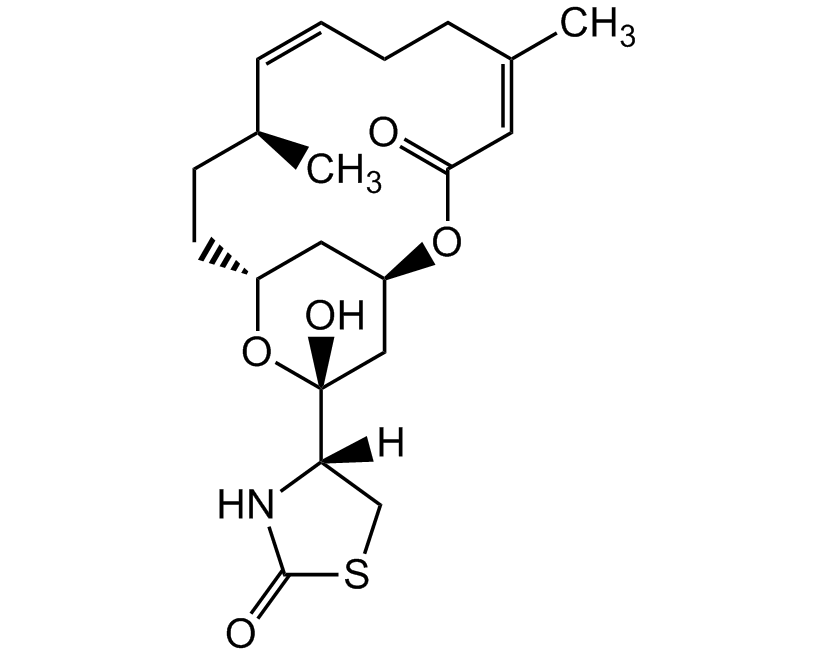Latrunculin B
Product Code: AG-CN2-0031
Product Group: Natural Products and Extracts
Supplier: AdipoGen Life Sciences
| Code | Size | Price |
|---|
| AG-CN2-0031-C500 | 500 ug | £120.00 |
Quantity:
| AG-CN2-0031-M001 | 1 mg | £185.00 |
Quantity:
Prices exclude any Taxes / VAT
Overview
Regulatory Status: RUO
Shipping:
Ambient
Storage:
+4°C
Images
Documents
Further Information
Alternate Names/Synonyms:
LAT-B; NSC 339663
Appearance:
Colorless viscous film
CAS:
76343-94-7
EClass:
32160000
Form (Short):
liquid
GHS Symbol:
GHS07
Handling Advice:
Protect from light.
Hazards:
H302, H312, H332
InChi:
InChI=1S/C20H29NO5S/c1-13-5-3-4-6-14(2)9-18(22)25-16-10-15(8-7-13)26-20(24,11-16)17-12-27-19(23)21-17/h3,5,9,13,15-17,24H,4,6-8,10-12H2,1-2H3,(H,21,23)/b5-3-,14-9-/t13-,15-,16-,17+,20-/m1/s1
InChiKey:
NSHPHXHGRHSMIK-JRIKCGFMSA-N
Long Description:
Chemical. CAS: 76343-94-7. Formula: C20H29NO5S. MW: 395.5. Isolated from Latrunculia magnifica. Cell permeable marine toxin. Disrupts microfilament-mediated processes. Actin polymerization inhibitor in vitro and in vivo by the formation of a 1:1 complex with monomeric G-actin. Depolymerizes actin filaments (F-actin). Less potent than Latrunculin A (Prod. No. AG-CN2-0027 http://www.adipogen.com/ag-cn2-0027/latrunculin-a.html ). May have fewer unwanted effects than latrunculin A and may be preferred for short-term studies. Acts via a different mechanism than cytochalasins.
MDL:
MFCD00270879
Molecular Formula:
C20H29NO5S
Molecular Weight:
395.5
Package Type:
Vial
Precautions:
P261, P280, P301, P312, P302, P352, P304, P340
Product Description:
Cell permeable marine toxin [1]. Disrupts microfilament-mediated processes [2]. Actin polymerization inhibitor in vitro and in vivo by the formation of a 1:1 complex with monomeric G-actin [1, 2, 3]. Depolymerizes actin filaments (F-actin) [3]. Less potent than Latrunculin A (Prod. No. AG-CN2-0027 http://www.adipogen.com/ag-cn2-0027/latrunculin-a.html ). May have fewer unwanted effects than latrunculin A and may be preferred for short-term studies [4, 5]. Acts via a different mechanism than cytochalasins.
Purity:
>98% (HPLC)
Signal word:
Warning
SMILES:
C[C@@H](CC[C@@H](O[C@]([C@@]1([H])NC(SC1)=O)(O)C2)C[C@H]2O3)/C=CCC/C(C)=CC3=O
Solubility Chemicals:
Soluble in DMSO (25mg/ml) or ethanol (25mg/ml).
Source / Host:
Isolated from Latrunculia magnifica.
Transportation:
Non-hazardous
UNSPSC Category:
Natural Products/Extracts
UNSPSC Number:
12352200
Use & Stability:
Stable for at least 2 years after receipt when stored at -20°C.
References
Latrunculins: novel marine toxins that disrupt microfilament organization in cultured cells: I. Spector, et al.; Science 219, 493 (1983) | Latrunculin inhibits the microfilament-mediated processes during fertilization, cleavage and early development in sea urchins and mice: G. Schatten, et al.; Exp. Cell Res. 166, 191 (1986) | Inhibition of actin polymerization by latrunculin: A: M. Coue, et al.; FEBS Lett. 213, 316 (1987) | Latrunculins-novel marine macrolides that disrupt microfilament organization and affect cell growth: I. Comparison with cytochalasin D: I. Spector, et al.; Cell Motil. Cytoskeleton 13, 127 (1989) | Effects of cytochalasin D and latrunculin B on mechanical properties of cells: T. Wakatsuki, et al.; J. Cell. Sci. 114, 1025 (2001) | RNAi screening identifies the armadillo repeat-containing kinesins responsible for microtubule-dependent nuclear positioning in Physcomitrella patens: T. Miki, et al.; Plant Cell Physiol. 56, 737 (2015) | Evidence that an unconventional actin can provide essential F-actin function and that a surveillance system monitors F-actin integrity in Chlamydomonas: M. Onishi, et al.; Genetics 202, 977 (2016)



